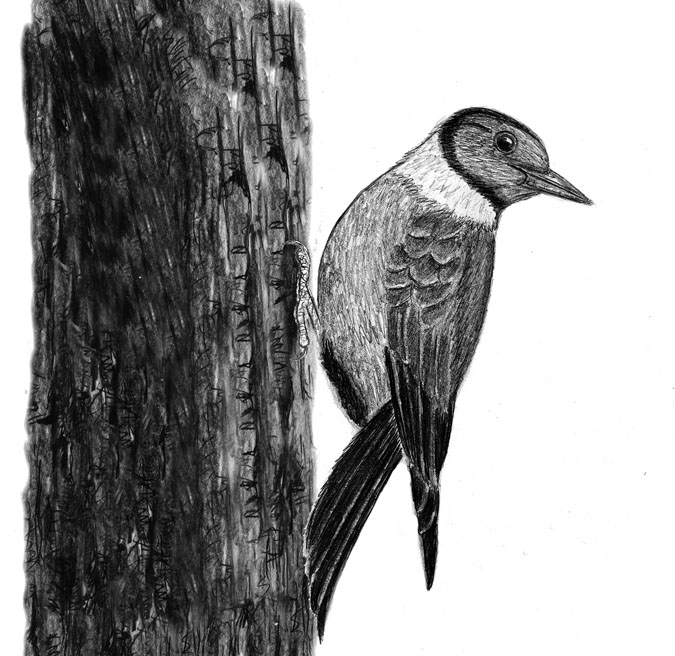
Bend, Oregon…again.
A few years ago I wrote about a trip my wife and I took to central Oregon. We explored the area around the trendy city of Bend. My wife did some horseback riding (what is it with women and horses?), while I mostly searched for birds…of course. We had a great time and apparently talked about it so much that my son became envious. So, this past Christmas, Casey asked for a birding trip to Bend. In particular, he wanted to go look for Lewis’s Woodpeckers. (Why couldn’t he just ask for a train set like other kids?) Not one to deny someone a birding trip, I quickly scheduled a return trip to Oregon for the two of us. After all, what kind of father would I be if I didn’t help my child find his first Lewis’s Woodpecker? It’s an avian right of passage.
Anyone who has seen a photo of a Lewis’s Woodpecker can easily understand why Casey would want to see one of these birds. Named after Meriwether Lewis, of Lewis and Clark fame, this is easily North America’s most colorful woodpecker. Looking like a giant hummingbird, the Lewis’s has an iridescent green back, a pink belly, a bright red face, and a white band around its neck. They are also extremely animated birds, often squabbling and chasing each other, and acting more like they were named after Jerry Lewis rather than Meriwether. They don’t even hunt like normal woodpeckers. Instead of spending their days picking at tree trunks (or drilling holes in our homes), Lewis’s Woodpeckers regularly catch insects in midair, flycatcher-style. There is one other reason Casey felt an urge to see this bird. Over the last few decades the population of this colorful woodpecker has dropped significantly. Now was the time to go.
Our flight into Portland was uneventful, which was a relief. Flying has become such a “drag” lately. After spending the night near the airport, we awoke to pouring rain. (Rain in the Pacific Northwest? Since when?) Casey was sure there would be no birding on this day. But I reminded him that we were headed to Bend, which is in the high desert. I predicted that we’d drive out of the rain. For the first few hours of the drive it looked as if I was going to eat those words. But once we moved out of the pine trees and into sagebrush the rain let up. Whew!
Our first stop was in the town of Tygh (yes, that’s how it’s spelled) Valley. Two weeks earlier a guy named, Doug, had posted sighting Lewis’s Woodpeckers near the fairgrounds. When we reached the junction of Springbrook Rd. and Fairgrounds Rd., I pulled the car over. I wasn’t sure if we had found the magical spot, but it seemed like a great place to try. It was a quiet road surrounded by horse-filled pastures and a rushing stream (Spring Brook?). If I were a bird, I’d live here. The minute we stepped out of the car my intuition proved to be correct. A flock of noisy scrub-jays immediately greeted us, followed by a dozen California Quail (the ones with the signature head plume). A Western Meadowlark was singing from a nearby fence post and a very active Say’s Phoebe was feeding from another post. Not bad for our first stop, eh?
We were seeing quite a few birds, but alas, no woodpeckers. We eventually made our way to the stream and checked for American Dippers. The stream had no dippers, but next to the stream was a large cottonwood tree and right on the very top of the cottonwood sat, you guessed it, a Lewis’s Woodpecker. Casey and I both pointed and yelled at the same time and were about to congratulate each other when we heard a commotion just above our heads. It was two more of the colorful woodpeckers and they were engaged in a full-fledged turf battle. We stood along the stream and watched the show for nearly an hour. As we headed back to the car, I looked at Casey and said, “Merry Christmas” (and I was really glad he didn’t ask for a train set.)
Seeing Lewis’s Woodpeckers on the first try on our first day was exciting, but now we had to find something to do for the rest of the week. What did we do? We kept birding, of course. Our next stop was beautiful Smith Rock State Park. This park is noted for rock climbing, but since I forgot to pack my rock climbing shoes, we had to stay on the trails and look for birds instead. The highlight of the hike was seeing an American Kestrel sitting high on a perch. As we watched the bird, which was peacefully eating its lunch, it suddenly took off in total panic mode. What spooked it? It was an Osprey. Even though Ospreys only eat fish, the little kestrel wasn’t taking any chances. Then something even cooler happened. Unbeknownst to us (and the Osprey and the kestrel), a Bald Eagle had a nest in a nearby pine tree and wasn’t about to let other predators near it. The giant eagle swooped down on the Osprey, causing it to flee even faster than the kestrel did. Ospreys can handle fish, but they are no match for a mama Bald Eagle.
The predator vs. predator vs. predator show gave us something to talk about until we finally arrived at our cabin. After supper, Casey told me about a wild refuge in southern Oregon that was famous for attracting huge numbers of migrating birds. I checked the map and noticed that the refuge was another two and a half hours away. I was getting ready to complain about making another long drive, when I caught myself. This trip wasn’t about me; instead I said, “We’ll leave first thing in the morning.”